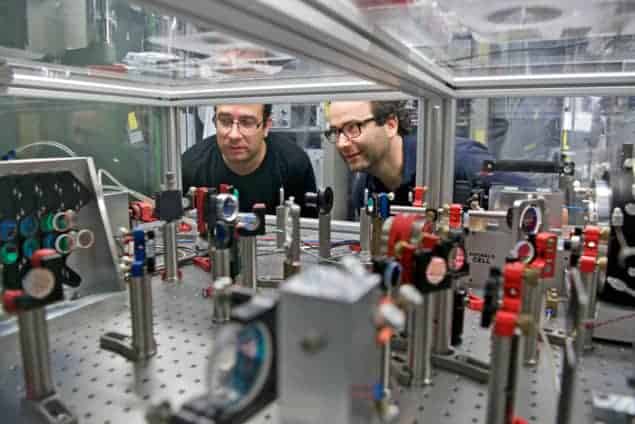
The “proton radius puzzle” has been reinforced by a precise measurement of an atomic transition in muonic deuterium, which suggests the radius of the deuterium nucleus is much smaller than expected. This latest result tallies with a similar experiment on muonic hydrogen, which found that the radius of the proton is also smaller than expected. The discrepancy could mean that theory describing how muons and electrons interact with the proton is incorrect, or that there is an error in how the radius is calculated. Another possibility is that the Rydberg constant – which defines the energy scale for atomic transitions in hydrogen – requires a slight correction.
In the decades after the proton was discovered in 1917, physicists began to realize that it has a finite size, unlike the electron, which is essentially a point particle. The internationally recognized proton radius is about 0.8751(61) fm, where the figure in brackets is the uncertainty. This has been measured using two methods that give similar results: electron scattering and atomic spectroscopy.
In 2010, however, an international team led by Randolf Pohl at the Max Planck Institute for Quantum Optics in Garching, Germany, carried out spectroscopic measurements of muonic hydrogen. This comprises a proton bound to a negative muon, which is a much heavier cousin of the electron. These studies suggested that the radius of the proton is only about 0.84087(39) fm – about 4% less than the currently accepted value and with a much smaller uncertainty.
Lamb shift
Spectroscopic measurements of proton radius come courtesy of the Lamb shift in hydrogen’s atomic-energy levels. This is a result of the electron (or muon) interacting with the quarks inside a proton as described by quantum electrodynamics (QED). These interactions are slightly different for electrons in the 2S and 2P energy levels, with the resulting energy shift depending partly on the radius of the proton. Measurements made on muonic hydrogen give a much more precise value for the proton radius because the muon, which is much heavier than an electron, spends more time very near to – and often within – the proton than does an electron.
In this latest experiment, Pohl and colleagues looked at the Lamb shift in muonic deuterium, which has a nucleus consisting of not just a proton, but a neutron too. Instead of giving the radius of the proton, this measurement provides a measure of the “deuteron charge radius”, which is a measure of the size of the deuterium nucleus.
The measurements were done at the Paul Scherrer Institute in Switzerland by firing a muon beam at deuterium gas, which makes some of the deuterium molecules break apart to create atoms of muonic hydrogen. About 1% of the time the muon finds itself in the 2S state, where it can be excited to the 2P state by absorbing a photon from a laser pulse. The 2P state then decays by emitting an X-ray. Counting the number of such X-rays, while scanning the frequency of the laser pulse, gives a very precise measurement of the photon energy required to drive the 2S–2P transition. A complicated QED calculation is then done to obtain the deuteron charge radius.
Still smaller
The team found the deuteron charge radius to be about 2.12562(78) fm, which is smaller than the currently accepted value of 2.1424(21) fm. They could also use the deuteron charge radius to calculate the proton radius. This was found to be about 0.8356(20) fm – much closer to the muonic hydrogen value than to the currently accepted radius.
One striking aspect of the proton radius puzzle is that measurements made using electrons – both via scattering and from spectroscopy – give one set of values for the proton radius and for the deuteron charge radius, while measurements made using muons give different answers.
According to Pohl and colleagues, these discrepancies are not easy to reconcile within the Standard Model of particle physics. One possible explanation is that the Rydberg constant that is used to calculate the radii is incorrect. There could also be an error in how QED is used to calculate the radii. Beyond the Standard Model, the team points out that the discrepancy could be caused by a new force between muons and protons. While this seems far-fetched, it could also explain why the measured value of the muon’s dipole magnetic moment differs from the value predicted by the Standard Model.
The research is described in Science.



